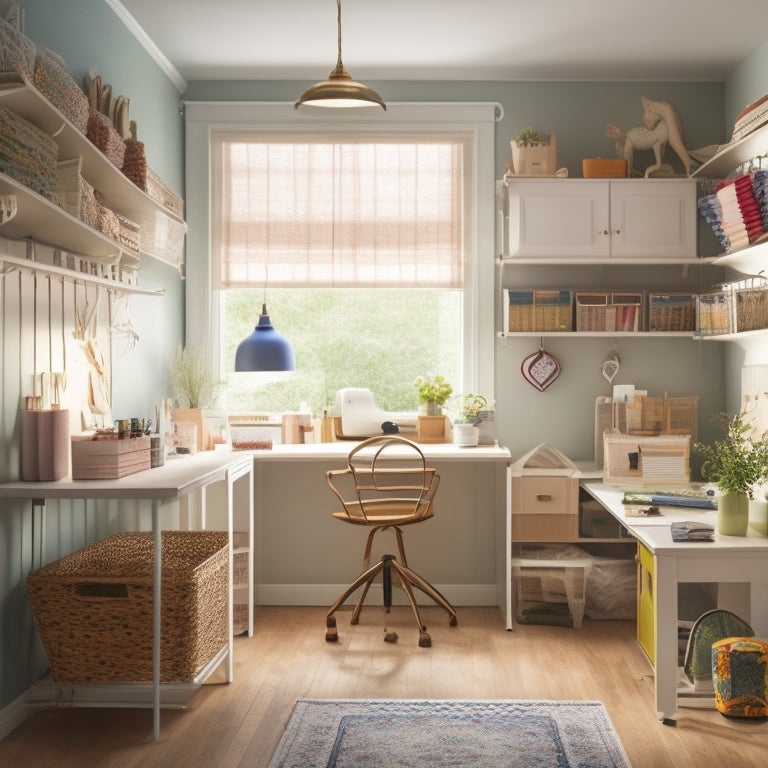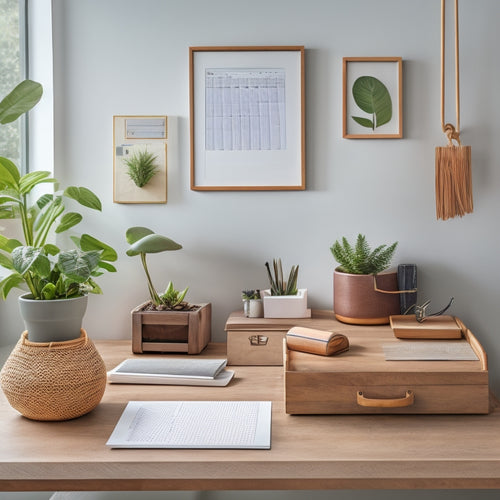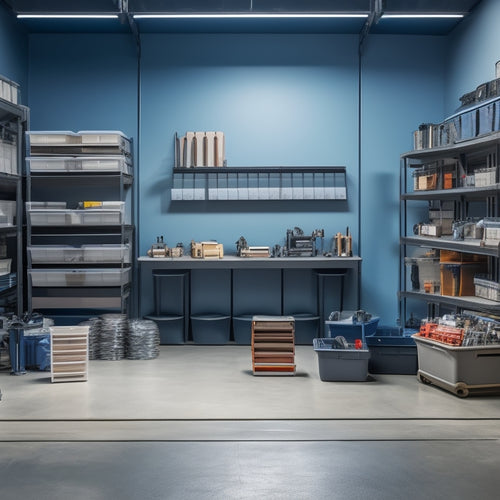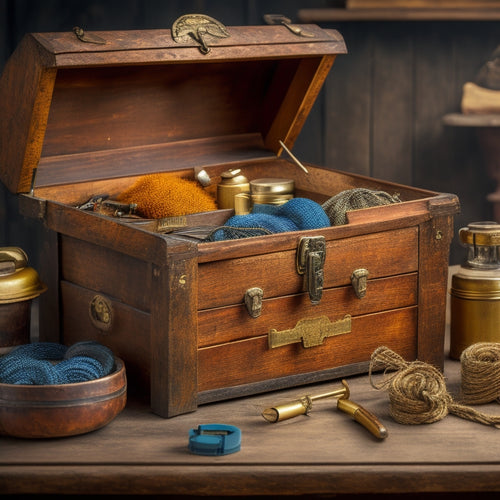
Efficient Sewing Zones Maximize Productivity and Space
Share
By strategically designing my sewing space into efficient zones, I've boosted productivity and transformed a cluttered area into a streamlined haven. Dedicated zones for cutting, piecing, pressing, and binding enable me to focus on specific tasks without disruptions. Portable storage solutions and intentional tool placement further optimize my workflow. A well-organized pressing zone, for instance, reduces downtime and enhances efficiency. By fine-tuning my space, I've created a sanctuary that supports my craft, and I'm excited to share the details that have made all the difference.
Key Takeaways
• Dedicated sewing spaces boost productivity by allowing projects to be left out without disruptions and enabling focus on the craft.
• Optimizing space for efficiency requires intentional design, portable storage solutions, and selective tool placement for seamless workflow.
• Four essential work zones - cutting, piecing, pressing, and binding - should be strategically positioned to streamline workflow and maximize productivity.
• A dedicated pressing zone with storage solutions and creative setups, such as wall-mounted boards and foldable tables, reduces downtime and enhances efficiency.
• Portable and semi-portable storage solutions can create dedicated areas and optimize sewing zones to maximize space and productivity.
Dedicated Sewing Space Benefits
Having a dedicated sewing space has been a game-changer for me, boosting my productivity and allowing me to leave projects out without worrying about minimizing disruptions. This luxury enables me to focus on my craft, rather than constantly setting up and tearing down my equipment.
Even in small spaces, a dedicated area can be created with portable storage solutions like a rolling cart. This versatile piece of furniture can serve multiple purposes and be useful in various spaces.
While a dedicated space is ideal, semi-portable storage solutions can be a suitable substitute. By implementing these strategies, I've been able to optimize my sewing zone, streamlining my workflow and maximizing my creative potential.
Optimizing Space for Efficiency
My sewing studio's compact footprint demands intentional design, so I've carefully curated my layout to prioritize functionality and efficiency.
To optimize space, I rely on portable storage solutions that offer multi-purpose functionality. A rolling cart, for instance, serves as a versatile workstation and storage unit, effortlessly gliding between tasks.
In a small space, every tool and equipment must earn its keep, so I'm selective about what I keep within arm's reach. By doing so, I've created a seamless workflow that minimizes clutter and maximizes productivity.
My Sewing Room Layout Evolution
Seven years of fine-tuning have transformed my 11.5 x 13 feet sewing space into a dynamic, efficient work zone that accommodates both quilting and guest room functions. Over time, I've made intentional changes to optimize the layout, ensuring every inch serves a purpose.
The room's flexibility is essential, as it must adapt to different needs. Future plans include setting up a cozy sitting area, which will require further adjustments to the sewing space. I've learned to prioritize functionality and flexibility, making improvements that enhance my quilting workflow.
Through trial and error, I've created a space that efficiently supports my creative process. As my needs evolve, so will the layout, ensuring a seamless fusion of form and function.
Essential Sewing Work Zones
I've identified four essential sewing work zones that form the backbone of my efficient sewing space, each tailored to a specific task and strategically positioned to streamline my quilting workflow. These zones are designed to maximize productivity, versatility, and space.
| Zone | Task | Key Features |
|---|---|---|
| 1 | Cutting | Large cutting mat, rotary cutter, and portable storage solutions |
| 2 | Piecing | Dedicated sewing machine, task lighting, and selectivity in tools |
| 3 | Pressing | Ironing board, iron, and mini pressing stations |
| 4 | Binding | Binding clips, walking foot, and small-space optimization |
Streamlining Pressing Operations
By designating a specific area for pressing operations, I can maintain a clutter-free zone that allows me to efficiently smooth out fabric, eliminating wrinkles and creases that can compromise quilting accuracy.
My ironing station efficiency is boosted by incorporating storage solutions, such as built-in shelves and drawers, to keep essential tools within easy reach.
Creative pressing setups can be achieved by utilizing wall-mounted ironing boards and foldable tables, maximizing space utilization.
By streamlining my pressing operations, I can reduce downtime and focus on the quilting process.
A well-organized pressing zone enables me to work more efficiently, ensuring that my quilts turn out smooth and precise.
Frequently Asked Questions
Can a Sewing Space Be Functional Without a Dedicated Ironing Board?
I've successfully used ironing alternatives like a portable ironing pad or a heat-resistant tray on a table, providing temporary solutions when a dedicated ironing board isn't feasible, and they've proven to be efficient and space-saving.
How Do I Prioritize Tools and Equipment in a Small Sewing Space?
I prioritize tools and equipment in my small sewing space by categorizing them into essential and secondary tools, allocating space accordingly, and utilizing vertical storage to maximize floor space, ensuring efficient workflow and reduced clutter.
Are There Any Space-Saving Hacks for Storing Large Fabric Bolts?
When storing large fabric bolts, I utilize fabric carts with vertical dividers and rolling shelves to maximize vertical space, ensuring easy access while keeping my sewing area clutter-free and visually organized.
Can a Sewing Zone Be Adapted for Other Crafting Activities?
"I coincidentally stumbled upon a versatile craft room idea that can adapt my sewing zone for mixed media projects, allowing me to repurpose my space and tools for a variety of creative pursuits."
What Are Some Creative Ways to Repurpose Old Furniture for Sewing Use?
I love giving old furniture a new life; I've successfully done a furniture flip by upcycling cabinets into sewing stations, adding custom inserts and storage, and refinishing them to match my studio's aesthetic, boosting functionality and style.
Related Posts
-

Best Organizing Tools for a Clutter-Free Space
You're on a mission to change your cluttered space into a peaceful oasis, and you're looking for the best organizing ...
-

How to Maximize Storage Space With Parts Storage Bins
To maximize storage space with parts storage bins, start by evaluating your available storage space and examining you...
-

What Are the Advantages of a Wooden Tool Box
You choose a wooden tool box, you're not only getting a reliable storage solution, but also a long list of benefits t...


